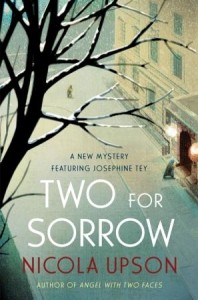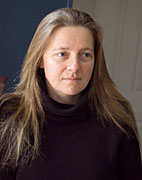 My special guest author is Nicola Upson, the author of Two for Sorrow which is based upon real-life mystery writer Josephine Tey.
My special guest author is Nicola Upson, the author of Two for Sorrow which is based upon real-life mystery writer Josephine Tey.
Two for Sorrow is set in the mid-1930’s. Tey sets out to pen a novel based upon two British women, Amelia Sach and Annie Walters, who were known as the “Finchley baby farmers” and hanged at Holloway Prison in 1903. Tey’s efforts ensnare her in the hunt for a current-day murderer. A young seamstress — an ex-convict attempting to begin her life anew — is sadistically slain in the studio of Tey’s friends, the Motley sisters, where preparations are underway for a charity ball. Tey’s friend, Inspector Archie Penrose, does not let appearances fool him. His instincts tell him that the murder is not the result of long-standing strained familial relationships.
Soon another young woman is involved in a horrific accident, convincing Penrose that his hunch is correct.
Writing About Crime and Capital Punishment
by
Nicola Upson
As a crime writer, I’m often asked what frightens me. Does working in a genre which forefronts hatred and violence trouble me, or have I ever given myself nightmares by reliving – in fiction – a particularly brutal killing? Perhaps the answer to that should be yes, but it isn’t: anyone who writes detective fiction will admit to being a little competitive about the murders they create. We all have a benchmark of unpleasantness which we try to live up to: for me, it’s the death of a student nurse in PD James’s brilliant novel, A Shroud for a Nightingale, and the closer I get to that darkness, the more satisfied I am with the book. It’s not just the competitiveness of the genre, though: there’s a serious side to why a murder must be the best – or worst – that you can make it. A contemporary crime novel, even if it’s set in the past, shouldn’t get away with treating death as an intellectual puzzle in the way that the Golden Age did, and the victim really has to matter – so I always kill off someone I care about, and I always try to make the violence as realistic as possible. The death and sense of loss should haunt the whole book – but, if I’m honest, it doesn’t keep me awake at night.
Another aspect of Two for Sorrow did give me nightmares, though. The idea for the book began with a real-life murder case from the early twentieth century, which revolved around the hanging of two baby farmers – Amelia Sach and Annie Walters – at Holloway Prison in London in 1903. It was the first execution at Holloway after its conversion to a women’s prison the year before, and the last double female hanging in Britain. What happened to those two women, and the relationship between them, fascinated me, and I was interested in how many lives their crimes touched. I’ve always thought it strange that the shadow of capital punishment should be so absent from crime fiction written during the Golden Age, when hanging was the inevitable conclusion to most successful murder investigations (Dorothy L. Sayers and Josephine Tey – the main character in my own novels – are two of only a handful of writers who address or even acknowledge it), so I wanted to begin my novel at the point where most detective novels end – the execution of the guilty party – and explore the aftermath. It’s nearly two years now since I finished writing Two for Sorrow – and there have been many other killings in between! – but the experience of recreating that execution is still with me; the claustrophobic horror of the condemned cell, knowing to the second the moment of your own death, the desperation and the fear – in my mind, it’s the most unsettling thing I’ve ever written, and I can’t think of anything which is likely to disturb me more in the future.
I’ve been lucky enough to grow up in a country that replaced the death penalty with mandatory life imprisonment in the 1960’s. The last hangings in Britain took place six years before I was born, so I didn’t spend my childhood glancing at the clock as the minute hand edged inevitably towards nine o’clock in the morning, wondering why my parents were looking knowingly across the breakfast table at each other and waiting for a solemn announcement from the BBC to confirm that justice had been done. The poster going up on the prison gates has been replaced in my lifetime by a closed van leaving a courtroom – a beginning rather than an end, even if the crowds drawn to both spectacles have similar motives. Many people reading this will know what it’s like to live in a society which endorses capital punishment, and they will have their own views, but – for me – it has always been a part of history. Naively, I thought it would stay that way.
Recently, though, the death penalty in Britain has come back into the frame. Our government has introduced a new website for e-petitions which allows members of the public to have an issue debated in parliament if they get enough support and, as I write, the two most popular petitions both call for the return of capital punishment. It’s likely that one of them will achieve the required 100,000 signatures to put hanging back on the political agenda, and hearing that news story the other day has given a new relevance to the horror and sadness I felt when I was writing the novel. How would I feel, I wonder, if that particular form of justice were not safely locked in the past or confined within the pages of a book?
Amelia Sach and Annie Walters committed what most people would regard as the most evil crime possible – the callous serial murder of babies for money. Baby farming was a loose term: at its best, it consisted of “farming out” unwanted children from single mothers into other families, like an unofficial adoption service; at its worst, it was a euphemism for infanticide. Amelia Sach ran a nursing home, where women went to give birth; some of them paid an additional fee – around £30 – to have their child adopted, but, in reality, Annie Walters would collect the baby from Sach’s house and dispose of it; Walters was paid 30 shillings for killing the baby, and Sach kept the rest. Researching the book, I got very close to that crime – to the handsome, respectable nursing home in Finchley, where Sach fooled vulnerable young women into giving up their unwanted babies, and to the house in Danbury Street, Islington, where Walters had lodgings and carried out the murders. I retraced Walters’s footsteps round London, walking the districts through which she carried a dead child as she looked for somewhere to dispose of the body, and I read the accounts of the trial and the doctor’s moving testimony of a child’s final moments. But if I were on a jury now, with the modern equivalent of Sach and Walters in the dock and the evidence stacked against them, could I contribute to a guilty verdict if I knew they were going to die? Rightly or wrongly, I honestly don’t think I could.
Like most crime writers, any empathy I have with the victims of violent crime is an imaginative one. I can’t say how I would feel if someone I love were murdered, and I hope to God I never find out. But exploring the aftermath of that execution in 1903 showed me that justice has its repercussions, too. Amelia Sach had a daughter who was only four years old at the time, and that child never had a chance to talk to her mother or come to terms with what she had done – hanging doesn’t offer that kind of solace, even to the innocent. William Billington, one of the hangmen, was utterly destroyed by the experience of executing two women and the warders who looked after Sach and Walters in the condemned cells during the three weeks between sentence and execution were permanently scarred by having to live with the distress of the prisoners. Too often, we ask people to do things that most of us would be incapable of, and the effects of that are lasting and far-reaching.
The arguments for and against capital punishment have been debated for years, both before and after abolition, and will no doubt continue in the wake of these new petitions. The sides are not always clearly drawn: at times during her long prison sentence, Moors murderer Myra Hindley is said to have begged for the death penalty; and, having researched prison conditions for women in England in the first half of the twentieth century, I can believe that the fate of Sach and Walters was, in some ways, the lesser of two evils. But my abhorrence of the death penalty has nothing to do with politics, or even, perhaps, with logic. It’s an emotional response, a feeling that a society which sanctions killing in any way is tainted, somehow. Dickens objected to the way in which public executions incited violence and hatred amongst spectators; but even locked away behind prison doors, the taking of a life must surely have some effect on us all?
Josephine Tey would have been fascinated by the Sach and Walters case: much of her work – The Daughter of Time, The Franchise Affair – takes another look at history, and Sach and Walters were in living memory for her. In Two for Sorrow, she starts to write their story in the form of a novel, and that was a great way for me to explore what it’s like to write a book about a real person whose life is, in part, a mystery – the journey which Josephine goes on in researching Sach and Walters, in trying to get to the essence of who they were, is very much like the one I take in recreating her. Because Two for Sorrow is quite dark, I’ve enjoyed developing a more personal storyline for Josephine alongside the murders. That, too, is based on fact: many of Tey’s closest relationships in real life were with women she’d met during the West End run of her play, Richard of Bordeaux. From April 1935 to March 1936, one of them – the actress, Marda Vanne – wrote her a year-long love letter in the form of a diary. I’ll never forget the day that my partner and I first discovered it, almost by accident, when we were following some other lines of Tey research – page after page of thin blue paper, covered in impossibly tiny handwriting. It’s written partly in code, and takes a lot of deciphering, but it’s an extraordinary piece of writing – loving, angry, funny, perceptive and scorchingly honest. Some of Marda’s words from the diary are quoted in Two for Sorrow, as part of an ongoing storyline between Josephine and another character. Crime writers – we can be great at violence and rubbish at love, so it’s been important to me to create a relationship which is about tenderness rather than power.
Meet Nicola

Since discovering the work of Golden Age author Josephine Tey/Gordon Daviot, Nicola has developed a passion for the theatre and literature of that period, as well as an admiration for those who wrote and performed between World War I and World War II. Her research has included many conversations with people who remember the time and who knew Josephine Tey, including Sir John Gielgud and Margaret Harris, one of the design team known as “Motley.”
Nicola lives with her partner, splitting her time between Cambridge and Cornwall.
You can connect with Nicola at her website, or via email.



3 Comments
Pingback: Nicola Upson, author of Two for Sorrow, on tour August 2011 | TLC Book Tours
Fictional stories about murders and killings is an art only a few have mastered. Though they say your imagination is the only limitation, it takes a very talented writer to give readers both entertainment and dread.
I have read about this book on several blogs. All have been very enthusiastic about this book. Thank you for the post.